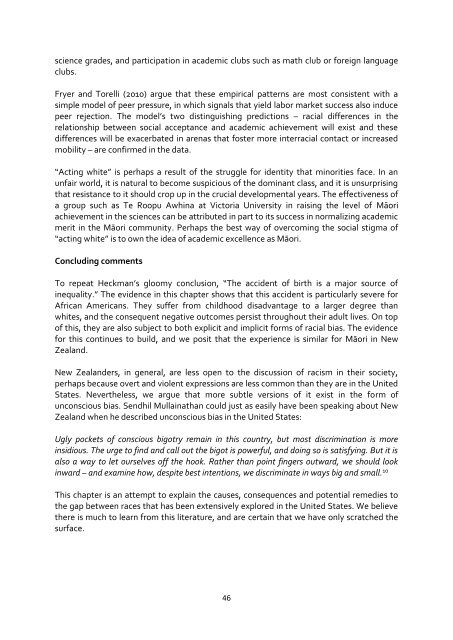UNCONSCIOUS BIAS AND EDUCATION
unconsious-bias-and-education
unconsious-bias-and-education
You also want an ePaper? Increase the reach of your titles
YUMPU automatically turns print PDFs into web optimized ePapers that Google loves.
science grades, and participation in academic clubs such as math club or foreign language<br />
clubs.<br />
Fryer and Torelli (2010) argue that these empirical patterns are most consistent with a<br />
simple model of peer pressure, in which signals that yield labor market success also induce<br />
peer rejection. The model’s two distinguishing predictions – racial differences in the<br />
relationship between social acceptance and academic achievement will exist and these<br />
differences will be exacerbated in arenas that foster more interracial contact or increased<br />
mobility – are confirmed in the data.<br />
“Acting white” is perhaps a result of the struggle for identity that minorities face. In an<br />
unfair world, it is natural to become suspicious of the dominant class, and it is unsurprising<br />
that resistance to it should crop up in the crucial developmental years. The effectiveness of<br />
a group such as Te Roopu Awhina at Victoria University in raising the level of Māori<br />
achievement in the sciences can be attributed in part to its success in normalizing academic<br />
merit in the Māori community. Perhaps the best way of overcoming the social stigma of<br />
“acting white” is to own the idea of academic excellence as Māori.<br />
Concluding comments<br />
To repeat Heckman’s gloomy conclusion, “The accident of birth is a major source of<br />
inequality.” The evidence in this chapter shows that this accident is particularly severe for<br />
African Americans. They suffer from childhood disadvantage to a larger degree than<br />
whites, and the consequent negative outcomes persist throughout their adult lives. On top<br />
of this, they are also subject to both explicit and implicit forms of racial bias. The evidence<br />
for this continues to build, and we posit that the experience is similar for Māori in New<br />
Zealand.<br />
New Zealanders, in general, are less open to the discussion of racism in their society,<br />
perhaps because overt and violent expressions are less common than they are in the United<br />
States. Nevertheless, we argue that more subtle versions of it exist in the form of<br />
unconscious bias. Sendhil Mullainathan could just as easily have been speaking about New<br />
Zealand when he described unconscious bias in the United States:<br />
Ugly pockets of conscious bigotry remain in this country, but most discrimination is more<br />
insidious. The urge to find and call out the bigot is powerful, and doing so is satisfying. But it is<br />
also a way to let ourselves off the hook. Rather than point fingers outward, we should look<br />
inward – and examine how, despite best intentions, we discriminate in ways big and small. 10<br />
This chapter is an attempt to explain the causes, consequences and potential remedies to<br />
the gap between races that has been extensively explored in the United States. We believe<br />
there is much to learn from this literature, and are certain that we have only scratched the<br />
surface.<br />
46


